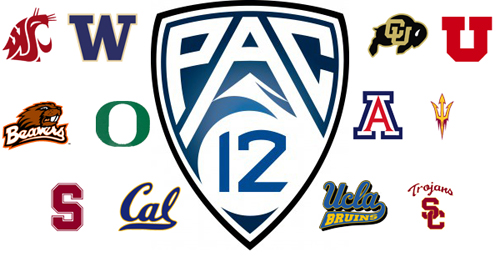The Hotline’s late-spring assessment of Pac-12 basketball rosters for the 2022-23 season confirmed our suspicion that the conference is positioned to improve on its showing from last season, when only three teams advanced to the NCAA Tournament.
But the process also revealed potential trouble from within. The greatest threat to the top of the standings might come from those at the bottom.
Just as quality wins bolster a team’s pursuit of the NCAAs, so do bad losses undermine that quest.
It’s the prop-up/drag-down nature of the selection process.
Given the ominous outlook for several teams — in particular, Cal and Oregon State — there could be an inordinate number of potholes for the NCAA Tournament hopefuls.
To the post-spring projections …
(Note: Each team’s position in our early-April rankings has been included.)
1. UCLA (previous: 1): The Bruins aren’t quite the clear favorite they were immediately following the season, not after Johnny Juzang, Jules Bernard and Peyton Watson bolted for the NBA. There are two five-star recruits on their way but no impact transfers, meaning the returning core (Jaime Jaquez Jr., Tyger Campbell and Jaylen Clark) must carry the load. We ran 10,000 simulations of the conference race through the Hotline’s supercomputer, and the Bruins finished first more than any other team — but far less than 50 percent of the time.
(Update: There is no supercomputer. We just threw a few darts.)
2. Oregon (3): The outlook has brightened considerably for the Ducks, particularly on the perimeter, with the return of guard Will Richardson and the arrivals of Jermaine Couisnard (South Carolina) and Keeshawn Barthelemy (Colorado). No team has more size, but it’s either unproven or oft-injured size. If former five-star recruit N’Faly Dante becomes more consistent (and stays healthy), Oregon will have a dominant big man to balance the experienced background and make a run at the regular-season title.
3. Arizona (2): The attrition was significant with Bennedict Mathurin, Christian Koloko and Dalen Terry off to the NBA, but there’s enough returning and incoming talent for the Wildcats to avoid a major backslide. Our projection improved last week when multi-year Texas starter Courtney Ramey picked Arizona, but the rotation remains flawed. The Wildcats shouldn’t have trouble scoring, but we’re skeptical of their ability to defend the perimeter without Mathurin and Terry, especially once March arrives.
Our projection improved last week when multi-year Texas starter Courtney Ramey picked Arizona, but the rotation remains flawed. The Wildcats shouldn’t have trouble scoring, but we’re skeptical of their ability to defend the perimeter without Mathurin and Terry, especially once March arrives.
4. USC (4): Our early-April position stands: “Barring unexpectedly high attrition, we see the Trojans finishing in the small grouping of teams below the top two but above the pack.” The last-minute draft reversals by guard Boogie Ellis and wing Drew Peterson ensured that USC will combine a solid returning core with one of the nation’s best-recruiting classes. We aren’t ready to slot the Trojans onto the top tier, but their roster is stout enough to contend for an opening-round bye in the conference tournament.
5. Colorado (5): Few teams were hit harder than CU, which lost star Jabari Walker to the NBA and guards Elijah Parquet and Keeshawn Barthelemy to the transfer portal. That said, Tad Boyle has a well-earned reputation for developing players, and we expect breakthrough seasons from point guard K.J. Simpson and forward Tristan da Silva. Whether the Buffaloes make a push for the top tier or fade to the pack depends on the remaining pieces, including two transfers from the Ivy League.
6. Stanford (10): The stagnant Cardinal received a rare piece of good news in late May when star forward Harrison Ingram withdrew from the draft. He’ll join Spencer Jones to give Stanford a gifted forward tandem — and a fighting chance to become relevant. There are legitimate questions about the backcourt generally, the 3-point shooting specifically and Stanford’s ability to succeed in the second half of league play. But if Ingram takes his game to the next level, the Cardinal will follow.
7. Arizona State (7): Another offseason of roster upheaval for the Sun Devils, who lost key players to the transfer portal and grabbed impact players from the transfer portal. Atop that list is Desmond Cambridge, who averaged 15+ points per game for four consecutive seasons at Nevada. (His brother, Devan, is arriving from Auburn.) We slotted the Sun Devils for the lower half of the conference but acknowledge their potential for an upside surprise. The downside risk from here, meanwhile, is limited.
8. Washington (8): The Huskies once again turned to the portal for salvation, and it delivered. The trio of center Franck Kepnang (Oregon), wing Noah Williams (Washington State) and forward Keion Brooks (Kentucky) should keep UW from dropping into the bottom tier. However, the ceiling is limited unless coach Mike Hopkins upgrades the perimeter with another transfer (or develops his returning players). Because anyone facing the Huskies as currently constructed should zone them all day and all night.
9. Washington State (6): Our outlook for the Cougars has deteriorated substantially following a spring exodus. The list of departed players features Williams (transfer), guards Tyrell Roberts (transfer) and Michael Flowers (eligibility) and big man Efe Abogidi (G League). They combined for 43 points per game — more than half the team’s average. It could have been much worse, but big man Mouhamed Gueye opted to return. If point guard Justin Powell (from Tennessee) is eligible, he will help immediately.
10. Utah (9): Admittedly, the Hotline has less clarity on Utah’s outlook than any other team. We know center Branden Carlson is one of the league’s top big men. Beyond that, production and success are difficult to project. The arrival of guard Mike Saunders from Cincinnati should help solidify the backcourt, but not to the point that we considered the Utes for a top-half finish. At least they don’t have to contend with expectations. After a poor Year One under Craig Smith, mediocrity is the goal in ’23.
11. Cal (11): Two months ago, we suggested the Bears could claim the cellar if big man Andre Kelly moved on. Well, Kelly took his 13 points and eight rebounds per game and transferred to UC Santa Barbara, but we haven’t moved the Bears from the No. 11 position. As depleted as the roster might be, Cal should have enough production to avoid last place. (It’s a low bar, folks.) Texas transfer Devin Askew will help immensely if eligible. The former four-star recruit has already changed schools once.
12. Oregon State (12): Coach Wayne Tinkle accomplished his No. 1 goal by sending a handful of rotation players to the transfer portal and thereby cleansing the program of its chemistry issues. Now comes the hard part: winning. We don’t see a quick fix in that regard. Not only is the roster utterly devoid of top-tier playmakers, it lacks the requisite number of mid-level talents. Sure, OSU’s locker room will be a happier place. But the scoreboard should be just as unforgiving as it was last season.
Support the Hotline: Receive three months of unlimited access for just 99 cents. Yep, that’s 99 cents for 90 days, with the option to cancel anytime. Details are here, and thanks for your support.
*** Send suggestions, comments and tips (confidentiality guaranteed) to pac12hotline@bayareanewsgroup.com or call 408-920-5716
*** Follow me on Twitter: @WilnerHotline
*** Pac-12 Hotline is not endorsed or sponsored by the Pac-12 Conference, and the views expressed herein do not necessarily reflect the views of the Conference.
Related posts:
 Wilner Hotline – Pac-12 Mailbag, Big Miss on Arizona Basketball, More
Wilner Hotline – Pac-12 Mailbag, Big Miss on Arizona Basketball, More

(AP Photo/Rick Scuteri)
Wilner Hotline – Pac-12 Rewind, It’s a Three-Bid League for NCAAs Unless…
(AP Photo/Marcio Jose Sanchez)
Wilner Hotline – Pac-12 Moving Out of Bay Area
(AP Photo/Ralph Freso, File)
Brandon Huffman Pac-12 Recruiting NotebookJon Wilner
Jon Wilner has been covering college sports for decades and is an AP top-25 football and basketball voter as well as a Heisman Trophy voter. He was named Beat Writer of the Year in 2013 by the Football Writers Association of America for his coverage of the Pac-12, won first place for feature writing in 2016 in the Associated Press Sports Editors writing contest and is a five-time APSE honoree.
